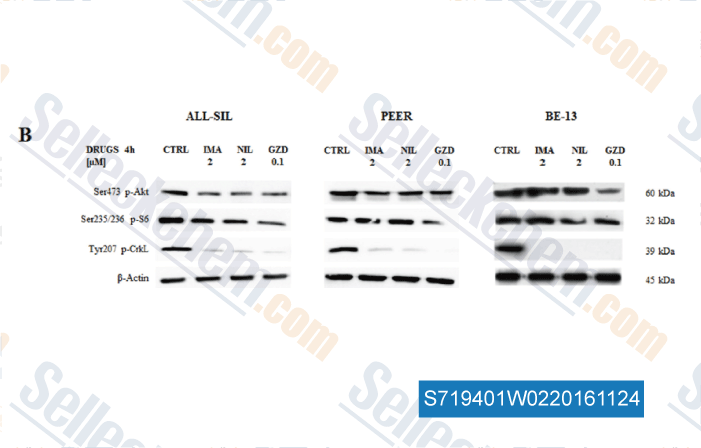|
How to Cite 1. For In-Text Citation (Materials & Methods): 2. For Key Resources Table: |
||
|
Toll Free: (877) 796-6397 -- USA and Canada only -- |
Fax: +1-832-582-8590 Orders: +1-832-582-8158 |
Tech Support: +1-832-582-8158 Ext:3 Please provide your Order Number in the email. We strive to reply to |
Technical Data
| Formula | C29H27F3N6O.2CH4O3S |
||||||||||
| Molecular Weight | 724.77 | CAS No. | 1421783-64-3 | ||||||||
| Solubility (25°C)* | In vitro | DMSO | 100 mg/mL (137.97 mM) | ||||||||
| Water | 100 mg/mL (137.97 mM) | ||||||||||
| Ethanol | Insoluble | ||||||||||
| In vivo (Add solvents to the product individually and in order) |
|
||||||||||
|
* <1 mg/ml means slightly soluble or insoluble. * Please note that Selleck tests the solubility of all compounds in-house, and the actual solubility may differ slightly from published values. This is normal and is due to slight batch-to-batch variations. * Room temperature shipping (Stability testing shows this product can be shipped without any cooling measures.) |
|||||||||||
Preparing Stock Solutions
Biological Activity
| Description | Olverembatinib (GZD824) dimesylate is a novel orally bioavailable Bcr-Abl inhibitor for Bcr-Abl(WT) and Bcr-Abl(T315I) with IC50 of 0.34 nM and 0.68 nM, respectively. | |||||||||||
|---|---|---|---|---|---|---|---|---|---|---|---|---|
| Targets |
|
|||||||||||
| In vitro | GZD824 potently inhibits the growth of Ba/F3 cells expressing wildtype Bcr-Abl with IC50 of 1.0 nM. Highly consistent with biochemical kinase inhibition and tight protein binding affinity, GZD824 also strongly inhibits the proliferation of Ba/F3 cells expressing Bcr-AblT315I mutant and 14 other resistance-relevant Bcr-Abl mutants. In addition, GZD824 efficiently suppresses the activation of Bcr-Abl as well as downstream Crkl and STAT5 in a concentration-dependent manner in K562 CML cells. [1] | |||||||||||
| In vivo | GZD824, at doses of 5 and 10 mg/kg/day, dose-dependently inhibits the tumor growth in the K562 tumor xenograft and the Ku812 xenograft model without mortality or significant body loss. Besides, GZD824 (20 mg/kg/day) suppresses tumor growth in mice bearing allografted Ba/F3 cells expressing Bcr-AblWT and Bcr-AblT315I. [1] |
Protocol (from reference)
| Kinase Assay:[1] |
|
|---|---|
| Cell Assay:[1] |
|
| Animal Study:[1] |
|
References
|
Customer Product Validation

-
, , Oncotarget, 2016, 7(48):79842-79853
Selleck's Olverembatinib (GZD824) dimesylate Has Been Cited by 6 Publications
| c-Abl kinase regulates neutrophil extracellular trap formation and lung injury in abdominal sepsis [ Lab Invest, 2021, 10.1038/s41374-021-00683-6] | PubMed: 34732849 |
| GZD824 Inhibits GCN2 and Sensitizes Cancer Cells to Amino Acid Starvation Stress [ Mol Pharmacol, 2020, 98(6):669-676] | PubMed: 33033108 |
| c-Abl kinase regulates neutrophil extracellular trap formation, inflammation, and tissue damage in severe acute pancreatitis. [ J Leukoc Biol, 2019, 106(2):455-466] | PubMed: 30861207 |
| The Lung is a Host Defense Niche for Immediate Neutrophil-Mediated Vascular Protection. [ Sci Immunol, 2017, 2(10)] | PubMed: 28626833 |
| PI3K isoform inhibition associated with anti Bcr-Abl drugs shows in vitro increased anti-leukemic activity in Philadelphia chromosome-positive B-acute lymphoblastic leukemia cell lines. [ Oncotarget, 2017, 8(14):23213-23227] | PubMed: 28390196 |
| Synergistic effects of selective inhibitors targeting the PI3K/AKT/mTOR pathway or NUP214-ABL1fusion protein in human Acute Lymphoblastic Leukemia. [Simioni C, et al. Oncotarget, 2016, 7(48):79842-79853] | PubMed: 27821800 |
RETURN POLICY
Selleck Chemical’s Unconditional Return Policy ensures a smooth online shopping experience for our customers. If you are in any way unsatisfied with your purchase, you may return any item(s) within 7 days of receiving it. In the event of product quality issues, either protocol related or product related problems, you may return any item(s) within 365 days from the original purchase date. Please follow the instructions below when returning products.
SHIPPING AND STORAGE
Selleck products are transported at room temperature. If you receive the product at room temperature, please rest assured, the Selleck Quality Inspection Department has conducted experiments to verify that the normal temperature placement of one month will not affect the biological activity of powder products. After collecting, please store the product according to the requirements described in the datasheet. Most Selleck products are stable under the recommended conditions.
NOT FOR HUMAN, VETERINARY DIAGNOSTIC OR THERAPEUTIC USE.
